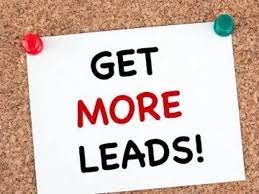Every business has one. For some, it’s a meticulously organized CRM. For others, it’s a chaotic collection of spreadsheets, email contacts, and old lead lists. We’re talking about your customer and prospect database.
Too often, this database is treated like a digital graveyard, a place where contact information goes to rest. But what if we told you that this “graveyard” is actually a goldmine? Hidden within your existing data is the power to dramatically increase your revenue, improve customer relationships, and create a predictable, high-performance sales engine.
You just need to know how to turn the key.
In this guide, we’ll walk you through the essential steps to transform your passive database into your most active and effective sales asset with Lead avail providing the solutions to make it happen.

Step 1: Start with a Deep Clean (Data Hygiene is Non-Negotiable)
You wouldn’t try to run a high-performance engine on dirty fuel. The same principle applies to your database. Before you can leverage your data, you must ensure it’s clean, accurate, and up-to-date.
Dirty data leads to:
- Wasted Time: Sales reps chasing dead-end leads.
- High Bounce Rates: Damaging your email sender reputation.
- Failed Personalization: Addressing contacts by the wrong name or company.
- Inaccurate Reporting: Making strategic decisions based on flawed information.
Your Action Plan:
- De-duplicate: Merge duplicate records for a single source of truth.
- Standardize: Ensure formats are consistent (e.g., “CA” vs. “California”).
- Verify & Validate: Use tools to verify that email addresses are still active and phone numbers are correct.
- Enrich: Fill in missing information like job titles, company size, or industry.
This foundational step is critical. A clean database is the bedrock upon which your entire sales engine is built.
Step 2: Segment, Segment, Segment (One Size Fits No One)
Once your data is clean, you can begin to understand who is actually in your database. Sending the same generic message to every single contact is the fastest way to get ignored. Segmentation is the art of grouping your contacts based on shared characteristics so you can tailor your messaging for maximum impact.
Effective Segmentation Strategies:
- By Demographics: Group contacts by industry, company size, job title (e.g., C-Level, Director, Manager), or geographic location.
- By Behavior: Segment based on how they’ve interacted with your brand. Have they opened previous emails? Visited your pricing page? Downloaded a specific whitepaper?
- By Purchase History: Create lists for active customers, high-value clients, one-time buyers, and churned customers. Each group requires a completely different approach.
- By Lead Source: How did they find you? Contacts from a trade show may need a different nurture sequence than those who found you through organic search.
By segmenting your list, you move from shouting at a crowd to having a meaningful conversation with a specific group of people who share a common interest or pain point.
Step 3: Implement Lead Scoring (Focus on the Hottest Prospects)
Not all leads are created equal. Some are just browsing, while others are ready to make a purchase decision today. Lead scoring is a system that assigns points to prospects based on their attributes and actions, allowing your sales team to instantly identify who is most engaged and sales-ready.
How Lead Scoring Works:
You assign positive (or negative) scores to different data points. For example:
- Job Title: C-Level Executive (+15), Manager (+10), Intern (+1)
- Industry: Target Industry (+10), Non-Target Industry (-5)
- Action: Visited Pricing Page (+20)
- Action: Downloaded Case Study (+10)
- Action: Unsubscribed from email (-50)
When a lead reaches a certain threshold (e.g., 100 points), they are automatically flagged as a “Marketing Qualified Lead” (MQL) or “Sales Qualified Lead” (SQL) and passed to the sales team for immediate follow-up.
This ensures your sales reps spend their valuable time on prospects who have demonstrated real interest, dramatically increasing their efficiency and conversion rates.
Step 4: Power Up with Personalization and Automated Nurturing
Now that you have clean, segmented, and scored data, it’s time to put it to work. This is where you build the engine’s machinery.
Automated Nurture Campaigns: Create automated email sequences that are triggered by a user’s behavior or segment.
- Welcome Series: For new subscribers.
- Educational Drips: For leads who downloaded an ebook, send them related case studies and blog posts over several weeks.
- Re-engagement Campaigns: For dormant contacts who haven’t interacted in a while, send a special offer or an update on new features to win them back.
This level of personalization shows you’ve done your homework and understand their specific needs, instantly setting you apart from the competition.

The ‘Easy Button’: How LeadAvail Accelerates the Process
Reading through these steps might feel overwhelming. Manually cleaning, segmenting, and enriching a database of thousands of contacts is a monumental task. Building custom outreach campaigns for each segment requires significant time and resources.
This is precisely where LeadAvail steps in.
LeadAvail isn’t just a data provider; we are your strategic partner in turning your database into a high-performance sales engine. We help you skip the manual grind and get straight to the results.
- Data as a Service (DaaS): Forget tedious data cleaning and enrichment. LeadAvail provides a continuously updated, verified, and enriched B2B database. We can take your existing Ideal Customer Profile (ICP) and instantly build a high-quality list of new, targeted prospects for you to engage.
- Intelligent Segmentation: Our platform allows you to easily filter and segment contacts using dozens of firmographic and demographic data points. Find your perfect audience in minutes, not weeks.
- Sales Engine Automation: We don’t just give you the data; we help you act on it. LeadAvail can design and execute multi-channel outreach campaigns on your behalf. We leverage your newly powerful database to send personalized emails and make strategic calls, nurturing leads and setting qualified appointments directly on your sales team’s calendar.
With LeadAvail, you get the power of a fully optimized database and the expert team to run the sales engine for you, freeing up your team to do what they do best: close deals.
Conclusion: Your Database is an Active Asset
Stop thinking of your database as a simple list of contacts. It is a living, breathing asset that holds the key to your future growth. By committing to keeping it clean, segmented, and active, you can build a reliable system that consistently generates high-quality leads and fuels your sales pipeline.
Transforming your database from a dusty archive into a dynamic sales engine is the single most powerful investment you can make in your company’s growth.
